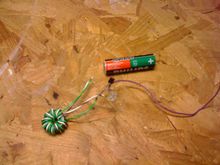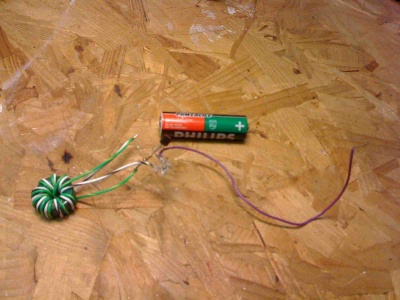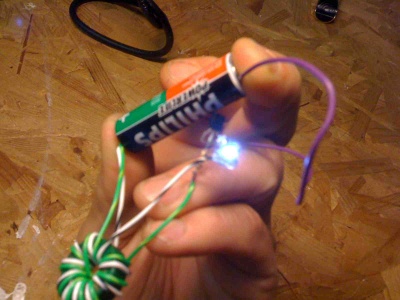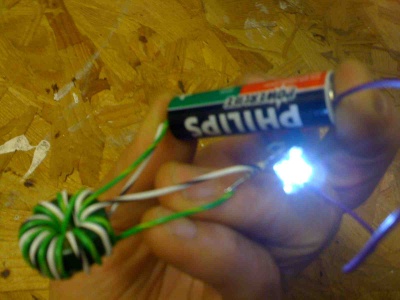Joule Thief: Difference between revisions
mNo edit summary |
m infobox and formatting |
||
| (7 intermediate revisions by 4 users not shown) | |||
| Line 1: | Line 1: | ||
{{Project | |||
|image=File:Joule_Thief_1.jpeg | |||
|name=Joule Thief | |||
|primary=[[User:Chunky|Chunky]] | |||
|created=25/10/2011 | |||
|completeddate=07/03/2012 | |||
|status=Complete | |||
|type=workshop | |||
|qrmode=1 | |||
}} | |||
The joule thief is a very simple circuit designed to power an LED from a battery with a very low voltage. It is designed to squeeze out energy from a battery which might otherwise be thrown away. Most devices which use AA and AAA batteries stop working when the battery voltage is below 1V. There is still some energy in the battery, down to around 0.8V. The Joule Thief is designed to step up that voltage to a useful level, such as to supply an LED. LED's need around 2.2V or higher (3.2V for white and blue LEDs) but not so much current (around 10-30mA). Basically it is a DC to DC converter from 0.8V to around 3.5V. | The joule thief is a very simple circuit designed to power an LED from a battery with a very low voltage. It is designed to squeeze out energy from a battery which might otherwise be thrown away. Most devices which use AA and AAA batteries stop working when the battery voltage is below 1V. There is still some energy in the battery, down to around 0.8V. The Joule Thief is designed to step up that voltage to a useful level, such as to supply an LED. LED's need around 2.2V or higher (3.2V for white and blue LEDs) but not so much current (around 10-30mA). Basically it is a DC to DC converter from 0.8V to around 3.5V. | ||
| Line 4: | Line 14: | ||
We found that from 3 different ferrites taken from different devices, one did not work, although that could have been my wire winding skills going wrong, so this might take some experimentation. | We found that from 3 different ferrites taken from different devices, one did not work, although that could have been my wire winding skills going wrong, so this might take some experimentation. | ||
Photos | =Photos= | ||
<gallery mode=packed-hover heights=200px> | |||
File:Joule_Thief_2.jpeg | |||
File:Joule_Thief_3.jpeg | |||
File:Joule_Thief_4.jpeg | |||
</gallery> | |||
=Links= | |||
*[http://www.evilmadscientist.com/article.php/joulethief Very good and simple circuit for the Joule thief] | *[http://www.evilmadscientist.com/article.php/joulethief Very good and simple circuit for the Joule thief] | ||
*[http://www.bigclive.com/joule.htm Joule thief circuits] | *[http://www.bigclive.com/joule.htm Joule thief circuits] | ||
*[http://en.wikipedia.org/wiki/Joule_thief Wikipedia entry Joule thief] | *[http://en.wikipedia.org/wiki/Joule_thief Wikipedia entry Joule thief] | ||
*[http://www.dr-iguana.com/prj_5VBoostRegulator/ 5V boost converter using SC120] | |||
*[http://rayshobby.net/?page_id=1383 5V boost converter using MCP1640] | |||
If interested in making one then ask for Spencer or Matt Little about it or just follow the links above. | If interested in making one then ask for Spencer or Matt Little about it or just follow the links above. | ||
Also check out [http://www.re-innovation.co.uk/joomla15/index.php?option=com_content&view=article&id=160:joule-thief-hack-get-more-energy-from-empty-batteries&catid=48:blog&Itemid=75 Matt Little's blog post about making these], which has a load of images. | Also check out [http://www.re-innovation.co.uk/joomla15/index.php?option=com_content&view=article&id=160:joule-thief-hack-get-more-energy-from-empty-batteries&catid=48:blog&Itemid=75 Matt Little's blog post about making these], which has a load of images. | ||
[[Category:Projects]] | [[Category:Projects]] | ||
[[Category: | [[Category:Projects (complete)]] | ||
Latest revision as of 15:50, 18 April 2019
| Joule Thief | |
|---|---|
 | |
| Primary Contact | Chunky |
| Created | 25/10/2011 |
| Completed | 07/03/2012 |
| Status | Complete |
| Type | Workshop Activity |
The joule thief is a very simple circuit designed to power an LED from a battery with a very low voltage. It is designed to squeeze out energy from a battery which might otherwise be thrown away. Most devices which use AA and AAA batteries stop working when the battery voltage is below 1V. There is still some energy in the battery, down to around 0.8V. The Joule Thief is designed to step up that voltage to a useful level, such as to supply an LED. LED's need around 2.2V or higher (3.2V for white and blue LEDs) but not so much current (around 10-30mA). Basically it is a DC to DC converter from 0.8V to around 3.5V.
These can be built (check the first link) from an NPN transistor, ferrite ring, resistor and the LED and a bit of wire. Lots of these parts can be found on old circuit boards, especially computer mother boards, power supplies and broken compact fluorescent lights. We found that from 3 different ferrites taken from different devices, one did not work, although that could have been my wire winding skills going wrong, so this might take some experimentation.
Photos
Links
- Very good and simple circuit for the Joule thief
- Joule thief circuits
- Wikipedia entry Joule thief
- 5V boost converter using SC120
- 5V boost converter using MCP1640
If interested in making one then ask for Spencer or Matt Little about it or just follow the links above. Also check out Matt Little's blog post about making these, which has a load of images.


